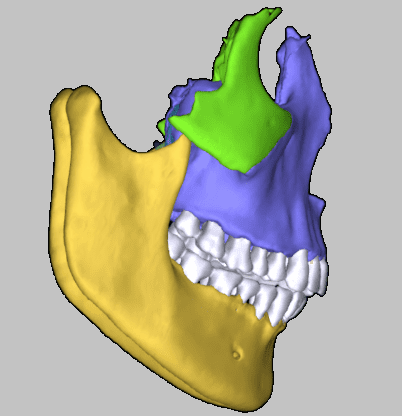Headgear Results
Improving a recessed maxilla with orthodontic headgear.

It is often debated whether orthodontic treatment is able to achieve positive results on facial appearance. On this page, we show cases where people used orthodontic headgear to remodel their maxilla. These results typically increase the facial attractiveness of the user because the headgear helps improve the development of a recessed maxilla.
The Recessed Maxilla and its Consequences
Having a recessed maxilla is problematic because it decreases facial attractiveness and causes functional problems. Since the maxilla is the bone that makes up most of the face, it heavily influences facial attractiveness. A recessed maxilla is typically smaller, elongated and more set back than a properly developed maxilla. This results in several traits that are considered unattractive such as a long and narrow face, sunken cheekbones, set back jaw, tired eyes, crowded teeth, and a crooked nose. If you have any of these traits, it is likely that you, just like most of the western population, suffer from craniofacial dystrophy that results from having a recessed maxilla.

Having droopy eyes that constantly look tired can be due to a recessed maxilla. When the top jaw is not supported by the tongue, it grows vertically (down) as opposed to horizontally (forward). This results in protrusive eyes that show too much white-of-eye and that look tired due to sagging eyelids.
A recessed maxilla can result in a weak chin. Look at your face from a profile view and see if you like the position of your chin. This is an interesting indicator because good looking faces typically have a strong chin. If yours is set back, it is likely due to having a recessed maxilla because the development of the lower jaw is heavily influenced by the development of the upper jaw. Having a weak chin also tends to cause a double chin, even if body fat is not particularly excessive.
Excessive gum display is a feature that is typically considered unattractive and that results from a face that grew downwards. This is because the maxilla was not properly supported by the tongue during the growth of the skull, which causes it to elongate and show gum. Good looking faces typically do not show much gum when they smile and the more gum that shows the less attractive the face tends to be.
In addition to the esthetic drawbacks, having a recessed maxilla also comes with a set of functional problems. For example, when the maxilla is set back, the size of the airway is reduced which can result in snoring and even sleep apnea. Young children rarely suffer from sleep apnea because they tend to have a good facial structure. However, as they age with bad habits such as mouth breathing, the maxilla grows into a recessed position which negatively impacts the airway. Developing a recessed maxilla during growth is also a reason why many people tend to look worse as adults than as kids. In the picture below, we see the effect of performing double jaw surgery on the airway of a patient. By moving the maxilla and the mandible forward, the size of the airway drastically increases which helps improve breathing ability. In fact, some maxillofacial surgeons perform double jaw surgery with the main objective of curing sleep apnea by increasing the size of the patient’s airway.
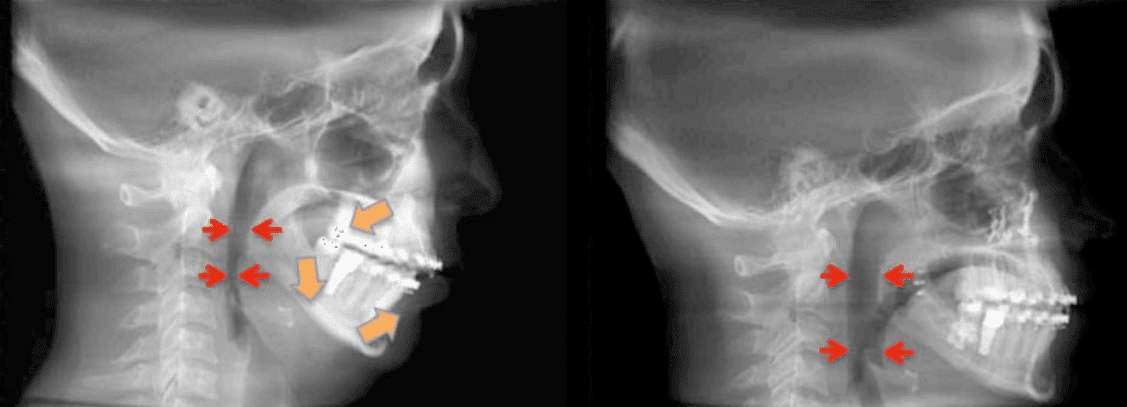
Another common problem associated with a recessed maxilla is the temporomandibular joint (TMJ) syndrome. It is actually a common disorder that affects up to 33% of all people in their lifetime. This causes pain at the joint that connects the mandible to the temporal bone. This is a particularly unfortunate outcome of having a recessed maxilla because it can cause chronic pain that might require surgical intervention to cure. Additionally, once the joint has been badly damaged, complete repair may be impossible.
The Mewing Appliance ™
According to the Tropic Premise, a person will develop a recessed maxilla because they are unable to maintain a proper tongue posture. To solve this problem, we created the Mewing Appliance ™ , a tool designed to help you maintain perfect tongue posture at all times. When placed in the mouth, it acts as a constant reminder to Mew properly by keeping the tongue flattened against the palate. Use the Mewing Appliance ™ to help remodel a recessed maxilla, improve facial esthetics and improve breathing ability.

The Orthodontic Headgear
An orthodontic headgear is a mechanical device used to remodel the facial bones of a user by applying external forces. For example, the Facepulling Headgear uses elastics to apply a forward and upward force on the maxilla. It aims to reproduce the forces generated by the tongue, but to a greater extent so that results can be achieved in a shorter period of time. In addition, the intra-oral appliance of the Facepulling Headgear is embedded with an expansion screw that can be used to widen the maxilla. There are different types of headgear and they are commonly used during orthodontic treatment.

Headgear Results
Below, we present successful cases of remodeling a recessed maxilla with the use of orthodontic headgear. Although this method is most effective in children because they are still growing, we also present successful adult cases. Additionally, there is scientific literature that indicates that headgear treatment can still be effective on adults even if their growth phase has ended. In particular, this study shows that human skull bones remain malleable until the eighth decade of life.
Improving a recessed maxilla with orthodontic headgear
Below is a patient that was treated at the orthotropic clinic by Dr. Mike Mew. At 17 years of age, she had already been through most of her growth which made it difficult to perform the traditional orthotropic treatment. Dr. Mew used the MewVector, a custom-designed headgear to remodel her maxilla. He mentions in the case study video that she was committed to the treatment, which is important because wearing the headgear requires high compliance.

Remodeling the recessed maxilla of an adult with a four-month headgear treatment
A study by Jackson and Kravitz shows the successful treatment of a 19-year-1-month-old Caucasian female presented with a chief complaint of “I do not like my underbite.”. Treatment was with nonextraction, comprehensive edgewise mechanics with slow maxillary expansion with a bonded expander and protraction headgear. The treatment had a positive effect on her facial appearance and the study even shows that bone structure remodeled in as little as 4 months. This paper is great because it is a peer-review clinical study showing that facial bone structure can be modified even in adults. Note that compliance was high as the “the patient agreed to four months of protraction (during the summer while out of school) for 18–20 hours per day.”.
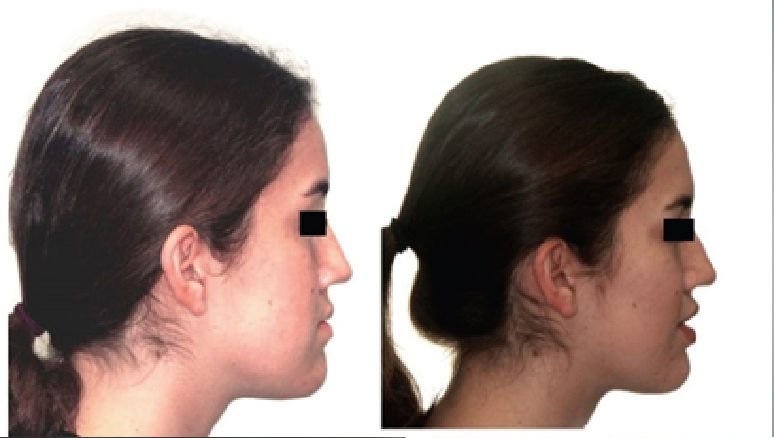
Clinical experiment on adult monkeys shows that maxilla remodeling is possible in adults
Dr. Ravindra Nanda achieved dramatic results with maxillary protraction on adult monkeys using orthodontic headgear. In the experiment, they applied 500 grams of forward force to the palate of adult rhesus monkeys for 4 months and saw drastic changes in their facial bone structure. Again, treatment compliance was high because the monkeys wore the orthodontic headgear for 24 hours per day. This study is another source of clinical evidence that bone remodeling is possible for adults, even if the growth phase has passed.
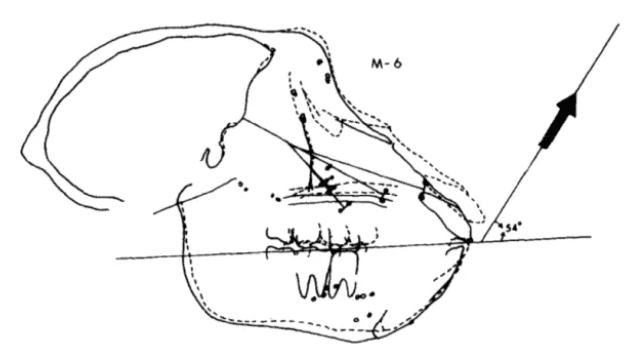
Esthetic improvement of correcting a recessed maxilla with orthodontic headgear
In their paper, Kircelli et al. investigate the effects of headgear treatment with a rigid skeletal anchor. This child was treated for midface deficiency by using an orthodontic headgear to protract her recessed maxilla. To pull the maxilla forward without affecting the teeth, orthodontic bollards were surgically implanted on the child’s upper jaw. Then, an orthodontic headgear and elastics were used to apply a forward force that is transferred directly to the bone. As a result, “Maxillary and infraorbital advancements were 5.7 and 4.4 mm, respectively.”. The infraorbital rim is the upper part of the maxilla that supports the eyes and we can see in the transposed x-rays the bone moved forward which resulted in an improved facial appearance for the child.

Clinical headgear treatment to remodel the recessed maxilla of an adult
Showkatbakhsh et al. published a case study on bone remodeling to correct the recessed maxilla of a patient after growth cessation. The 22-year-old patient refused to undergo surgery and was treated with teeth-anchored appliances. She also wore a reverse pull headgear for six months to protract her maxilla to a more favorable position. This remodeled her recessed maxilla and led to an improved facial appearance. The peer-reviewed paper concludes that “Nonsurgical treatment of adult class III patients is a difficult procedure; however, this patient was treated nonsurgically”.
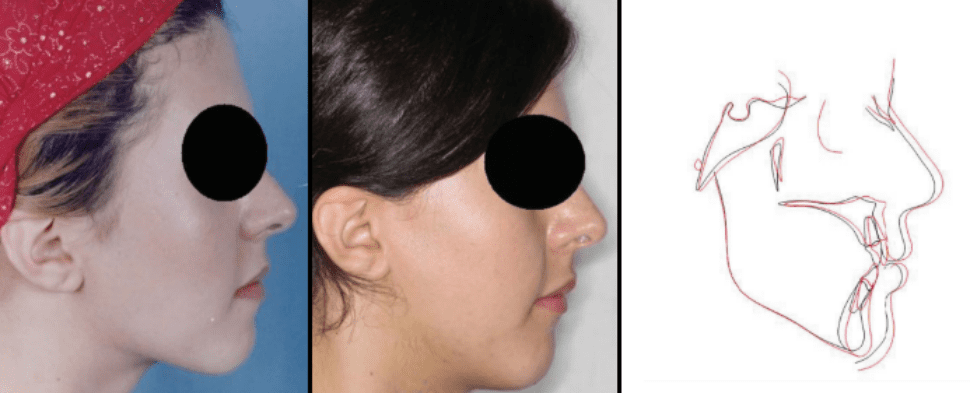
Clinical treatment to expand an adult maxilla without surgery
In their study, Singh et al. use a removable appliance to expand the maxilla of 25 adults without surgery. Then, they measure both the skeletal changes and the soft tissue changes of the face to determine how much volume they were able to add to the facial structure of their patients. The 25 patients, with a mean age of 39 years old, were instructed to wear the Homeoblock appliance between 10 and 16 hours per day, mostly at nighttime. The Homeoblock, which contains an expansion screw, was enlarged by one turn (0.25mm) every week of the treatment until the desired width was achieved. As a result, the maxillary arch showed on average a 30% relative size increase in the transverse direction. For facial changes, an average of 10% increase in volume was localized in the nasomaxillary region. As conclusion, the paper states that “[…] facial changes associated with the Homeoblock appliance are consistent with a broader smile and a more symmetrical facial appearance in non-growing adults.”.

Maxillary expansion on a 37-year-old adult
This patient was treated at the orthotropic clinic with semi-rapid maxillary expansion. With the use of an intraoral appliance, her palate was non-surgically expanded at the rate of one millimeter per week. In her before-after photos, we see an improvement in facial esthetic that come from the remodeling of her maxilla.
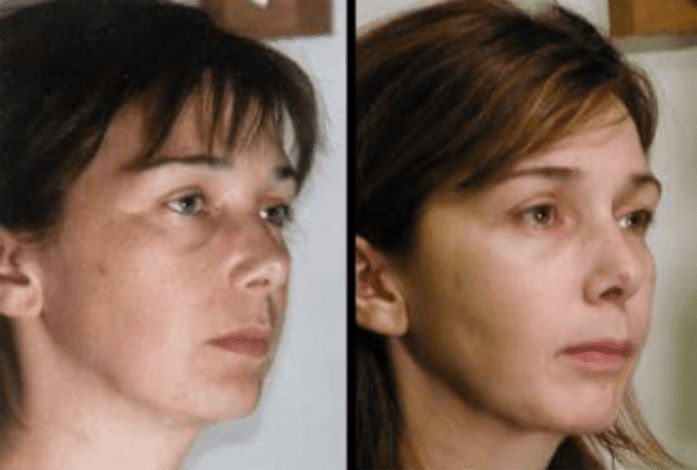
Non-surgical adult palate expansion progress of eight months
This is another patient of Dr. Mike Mew treated at the orthotropic clinic. Her cheekbones appear wider and her face fuller due to her maxilla expanding. It’s interesting to note that this result was achieved in as little as eight months in a non-growing adult. In the video presentation of this case, Dr. Mike Mew claims that, contrary to traditional belief, non-surgical palatal expansion is possible in adults.

Conclusion
On this page, we discuss the problem of having a recessed maxilla and we present studies that were successful in treating this deficiency. Although the non-surgical approach is traditionally used on children because it is more effective during growth, we see that practitioners were also able to achieve positive results on adults. By using an orthodontic headgear, practitioners aim to replicate the supporting effect of the tongue on the maxilla, but to a greater extent to achieve results in a reduced amount of time. Our mission is to provide the tools and information necessary to fight craniofacial dystrophy and help people improve their facial appearance and breathing ability.
